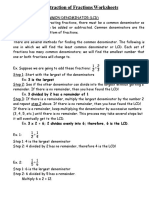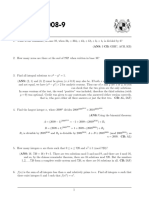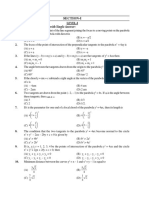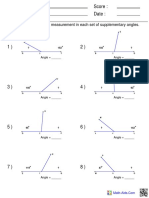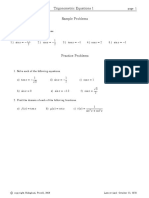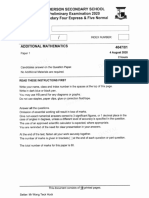Math SA1 - Fractions
Uploaded by
shereensaintsoutaneMath SA1 - Fractions
Uploaded by
shereensaintsoutaneSA-1 PROJECT
Name - Aradhana Prassanna Kumar
Student ID - CO-17-2-08
Topic - Fractions
Grade - 7A
Subject - Mathematics
School Name - The Indian public school
Date of Submission - 15/10/24
Guided By - Ms Swati S Thankam
- Math teacher in the Indian Public School North Campus.
Table of Content
Page no. Topic.
Introduction
Types of Fractions
How to Add and Subtract Fractions
Bibliography
Introduction
Fractions are an important part of math that help us understand parts of a whole. A fraction is
made up of two numbers: the top number, called the numerator, shows how many parts we have,
and the bottom number, called the denominator, tells us how many equal parts make up the
whole. For example, in the fraction 4/3 means we have three parts, and the 4 means the whole is
divided into four equal parts.
We will learn more about fractions, including different types like proper fractions, improper
fractions, and mixed numbers. We’ll also look at how we use fractions in real life, such as when
we cook, measure things, or share food.
Types of fractions
1. Proper Fractions
A proper fraction is when the numerator (the top number) is less than the denominator (the
bottom number). This means it represents a part of a whole. For example,2/5is a proper fraction
because 2 is less than 5.
2. Improper Fractions
An improper fraction is when the numerator is greater than or equal to the denominator. This
means it represents a whole number or more. For example, 7/4is an improper fraction because 7
is greater than 4.
3. Mixed Numbers
A mixed number combines a whole number and a proper fraction. For example, 2 ⅓ is a mixed
number because it has the whole number 2 and the proper fraction ⅓ . Mixed numbers are
another way to express improper fractions.
4. Equivalent Fractions
Equivalent fractions are different fractions that represent the same value or part of a whole. For
example, ½ is equivalent to 2/4and 4/8. They look different but are equal when simplified.
5. Like Fractions
Like fractions have the same denominator. This makes it easier to compare or add them. For
example, 14\frac{1}{4}41and 34\frac{3}{4}43are like fractions because they both have 4 as
the denominator.
6. Unlike Fractions
Unlike fractions have different denominators. For example, 13\frac{1}{3}31and
14\frac{1}{4}41are unlike fractions because their denominators (3 and 4) are different.
How to Add and Subtract Fractions
Adding Fractions
1. Same Denominator: If the fractions have the same bottom number (denominator), just
add the top numbers (numerators) together and keep the same denominator.
○ Example: ⅖ + ⅕ = 2+1 / 5 = ⅗
2. Different Denominator: If the fractions have different denominators, you need to find a
common denominator. This is usually the least common multiple (LCM) of the denominators.
○ Example: ¼ + ⅙
The LCM of 4 and 6 is 12.
■ Convert the fractions: ¼ = 3/12 and ⅙ = 2/12
■ Now add them: 3/12 + 2/12 = 5/12
Subtracting Fractions
1. Same Denominator: Just like with addition, if the denominators are the same, subtract
the numerators and keep the denominator the same.
○ Example: ⅝ - 2/8 = 5-2 / 8 = ⅜
○ Different Denominator: First, find a common denominator and then convert the
fractions before subtracting.
○ Example: ⅗ - ⅓
The LCM of 5 and 3 is 15.
■ Convert the fractions: ⅗ = 9/15 and ⅓ = 5/15
■ Now subtract: 9/15 - 5/15 = 4/15
Final Tips
● Always simplify your answer if possible. For example, 4/8 simplifies to ½ .
Conclusion -
Understanding fractions is a key math skill that will help you in many areas. By learning how to
add and subtract fractions—whether they have the same denominator or different ones—you can
tackle a variety of problems with confidence. Remember to always look for a common
denominator when necessary, and don’t forget to simplify your answers when possible. With
practice, you'll become more comfortable with fractions and be ready to take on even more
complex math concepts in the future.
Bibliography -
1. Byjus
2. Cuemath
3. Google
You might also like
- Maths the Wacky Way for Students...By a Student: From Foundation up to Higher Level GcseFrom EverandMaths the Wacky Way for Students...By a Student: From Foundation up to Higher Level GcseNo ratings yet
- GEd 104 Research Paper Content and FormatNo ratings yetGEd 104 Research Paper Content and Format3 pages
- Introduction To Fractions: What Is A Fraction?No ratings yetIntroduction To Fractions: What Is A Fraction?7 pages
- Presented By: Rizza M. Pacheo, Sr. Kristina Tay, Sr. War War, LwinNo ratings yetPresented By: Rizza M. Pacheo, Sr. Kristina Tay, Sr. War War, Lwin57 pages
- Performing Fundamental Operations With Fractions and DecimalsNo ratings yetPerforming Fundamental Operations With Fractions and Decimals35 pages
- 1Q M6 Module 1 Addition and Subtraction of Fractions FinalNo ratings yet1Q M6 Module 1 Addition and Subtraction of Fractions Final22 pages
- Fractions - Definition, Types, Properties and Examples100% (1)Fractions - Definition, Types, Properties and Examples19 pages
- Introduction To Fractions - HANDOUT DurhamNo ratings yetIntroduction To Fractions - HANDOUT Durham3 pages
- Adding & Subtracting Fractions _ Rules & Examples - Lesson 8No ratings yetAdding & Subtracting Fractions _ Rules & Examples - Lesson 87 pages
- MODULE 1 - Business Math: Fundamental Operations On Fractions, Decimals, and Percentage100% (1)MODULE 1 - Business Math: Fundamental Operations On Fractions, Decimals, and Percentage6 pages
- Addition and Subtaction of Similar FractionsNo ratings yetAddition and Subtaction of Similar Fractions10 pages
- Adding and Subtracting Fractions WorksheetsNo ratings yetAdding and Subtracting Fractions Worksheets14 pages
- Fractions: Adding and Subtracting: 1. 2 2. Fractions With Different Denominators 3 3. Mixed Fractions 5No ratings yetFractions: Adding and Subtracting: 1. 2 2. Fractions With Different Denominators 3 3. Mixed Fractions 56 pages
- Adding and Subtracting Fractions Worksheets0% (1)Adding and Subtracting Fractions Worksheets13 pages
- Math 501 Problem Set Topic: Fraction: Submitted To: Ms. Rosyl S. Matin-Ao, MAT-Math Submitted By: Buscagan, Valleree TNo ratings yetMath 501 Problem Set Topic: Fraction: Submitted To: Ms. Rosyl S. Matin-Ao, MAT-Math Submitted By: Buscagan, Valleree T7 pages
- (5) LP Adding and Subtracting Similar FractionsNo ratings yet(5) LP Adding and Subtracting Similar Fractions10 pages
- Adding Fractions With The Same DenominatorNo ratings yetAdding Fractions With The Same Denominator35 pages
- Adding and Subtracting Fractions Powerpoint100% (1)Adding and Subtracting Fractions Powerpoint23 pages
- Common_Fractions_Grade7_Namibia_with_VisualsNo ratings yetCommon_Fractions_Grade7_Namibia_with_Visuals3 pages
- Learning activity sheet_ LAS for adding and subtracting FractionsNo ratings yetLearning activity sheet_ LAS for adding and subtracting Fractions22 pages
- Adding Fractions Visually Third Edition Colour: Visual Mathematics Fractions, #3From EverandAdding Fractions Visually Third Edition Colour: Visual Mathematics Fractions, #35/5 (1)
- 393 MATHEMATICS SIMPLIFICATION Simplification Practice SheeNo ratings yet393 MATHEMATICS SIMPLIFICATION Simplification Practice Shee20 pages
- Advance math ques medium and hard with ansNo ratings yetAdvance math ques medium and hard with ans9 pages
- G3 MMC Reviewer - Perimeter and Area - Part 1No ratings yetG3 MMC Reviewer - Perimeter and Area - Part 12 pages
- MATHS101 - Sec.11 2022/2023: Calculus INo ratings yetMATHS101 - Sec.11 2022/2023: Calculus I24 pages
- Primary 4 Mathematics Placement Test (1)No ratings yetPrimary 4 Mathematics Placement Test (1)8 pages
- Maths Class X Question Bank For Sa II 2016 17No ratings yetMaths Class X Question Bank For Sa II 2016 17163 pages
- Name: Teacher: Date: Score:: Find The Missing Angle Measurement in Each Set of Supplementary AnglesNo ratings yetName: Teacher: Date: Score:: Find The Missing Angle Measurement in Each Set of Supplementary Angles2 pages
- Concept Area and Perimeter of Plane FigureNo ratings yetConcept Area and Perimeter of Plane Figure63 pages
- Md. Zahangir Hossain (ZHN) : Department of Mathematics and Physics North South University EmailNo ratings yetMd. Zahangir Hossain (ZHN) : Department of Mathematics and Physics North South University Email17 pages
- Trigonometric Equations 1: Lecture NotesNo ratings yetTrigonometric Equations 1: Lecture Notes4 pages
- Combined Maths - E - (Paper I & II Answer Guides)No ratings yetCombined Maths - E - (Paper I & II Answer Guides)41 pages
- O Level A Math Anderson Sec Prelim 2020iNo ratings yetO Level A Math Anderson Sec Prelim 2020i71 pages





























